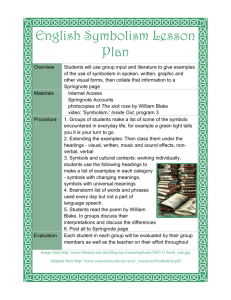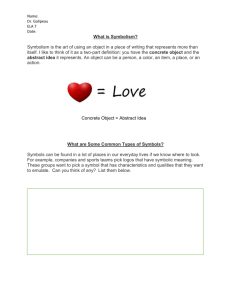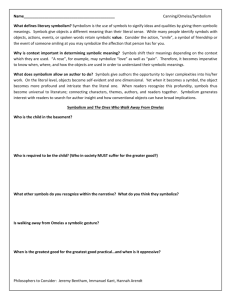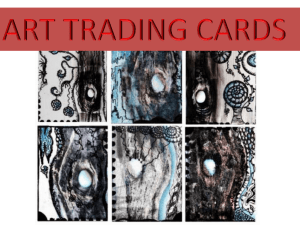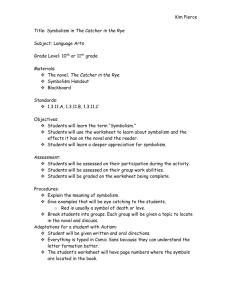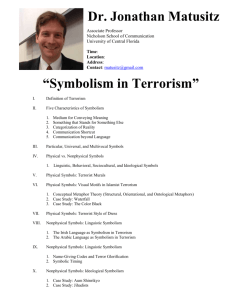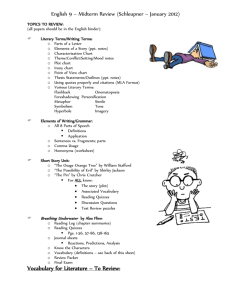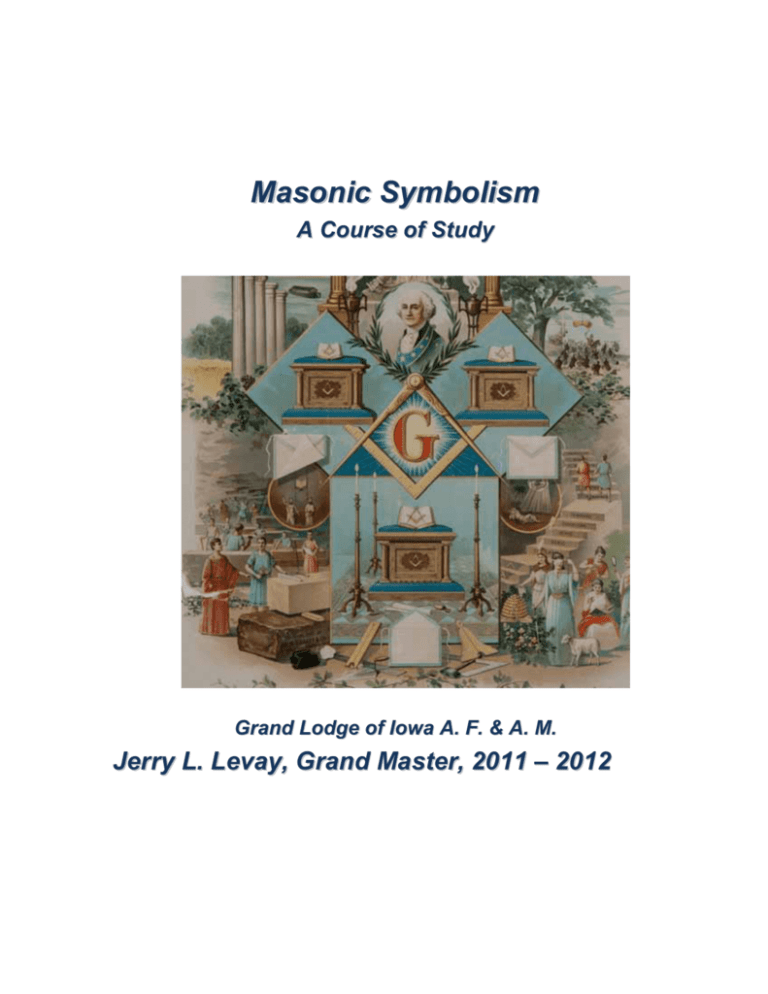
Masonic Symbolism
A Course of Study
Grand Lodge of Iowa A. F. & A. M.
Jerry L. Levay, Grand Master, 2011 – 2012
This taken from a Masonic Record belonging to W. M. Salmon, a member of
Buslington Lodge No. 440, Spanish Fort. Copyright 1901 by M. C. Lilley & Co.,
Columbus, OH.
Masonic Symbolism
A Course of Study
Grand Lodge of Iowa A. F. & A. M.
Jerry L. Levay, Grand Master, 2011 – 2012
The introduction, procedures and syllabus contained in this work were developed and written by
Brother George J. Harrison, PM. All rights reserved. Copyright is pending.
Sioux City Scottish Rite, Sioux City Iowa, September, 2011
Table of Contents
Why A Course in Masonic Symbolism?.......................................................................... ii
Studies in Blue Lodge Symbolism, by Brother H.L. Haywood ....................................... iv
Study Procedure, Study Groups & Recognition ............................................................ ix
Symbolism 101, 1st Degree Syllabus ............................................................................. 1
Symbolism 101, 2nd Degree Syllabus ............................................................................ 2
Symbolism 101, 3rd Degree Syllabus ............................................................................ 3
Symbolism 201 Syllabus ............................................................................................... 4
Appendix, Supporting Materials and Websites .............................................................. 5
SYMBOLISM OF THE THREE DEGREES by Oliver Day Street .................................. 7
Why “A Course on Masonic Symbolism?”
Grand Lodge of Iowa, A. F. & A. M.
Jerry L. Levay, Grand Master, 2011 - 2012
Introduction
In his Encylopedia of Freemasonry Brother Albert G. Mackey defines SYMBOL as
a visible sign with which a spiritual feeling, emotion, or idea is connected. He points
out that the ancient Egyptians and early Christians both used the names of symbols
to identify their rites and outward forms that bore a religious meaning, and, in fact,
that man’s earliest instruction was by means of symbols. “The first learning of the
world,” says William Stukely, a scholar and antiquarian best known for his studies of
Stonehenge, “consisted chiefly of symbols. The wisdom of the Chaldeans,
Phoenicians, Egyptians, Jews, of Zoroaster, Sanchuniathon1, Pherecydes, Syrus,
Pythagoras, Socrates, Plato, of all [the] ancients that [has] come to our hand[s], is
symbolic.” (Encyclopeadia of Freemasonry, Vol. II, pg 751)
In the preface of his work, The Symbolism of Freemasonry, he says, “Of the
various modes of communicating instruction to the uninformed, the masonic student
is particularly interested in two; namely, the instruction of legends and that by
symbols. It is to these, almost exclusively, that he is indebted for all that he knows,
and for all that he can know, of the philosophic system which is taught in that
institution.”
Even in our ritual we tell each of our petitioners that Masonry is taught through
symbols, “Masonry consists of a regular course of ancient hieroglyphical moral
instruction, taught agreeably to ancient usage by types, emblems and allegorical
figures.”
Symbols are, after all, the precursor to the alphabet, for like letters that combine
to form words to communicate, so symbols may be combined to convey a concept.
Take for example a simple pin prick, a point, if you will, created by one point of the
compass that becomes the pivot to inscribe a circle, giving a point within a circle.
Now take the compass and from any point on the circle, divide it into six equal
sections. Connect the sections in the right way and you can prove a square, create a
pentagram and a pentagon. Try it. It works.
Despite all that symbols teach us, despite all the credence we give to the
supposed study of the their meaning, most of us ignore them. Even as long ago as
1866, John Sherer, a noted student of symbolism and designer of tracing boards,
stated in the Preface of his book Masonic Ladder or the Nine Steps to Ancient
Freemasonry (R. W. Carroll & Co., Cincinnati, 1874), “The great number of Masons
do not sufficiently discriminate between the doctrines, covenants and aims of the
1
Sanchuniathon, a purported Phoenician author of three lost works originally in the Phoenician language,
surviving only in partial paraphrase and summary of a Greek translation by Philo of Byblos. These few
fragments comprise the most extended literary source concerning Phoenician religion in either Greek or Latin:
Phoenician sources, along with all of Phoenician literature, were lost with the parchment on which they were
habitually written.
ii
different degrees. The Three, Seven, or Nine Degrees, conferred in the various
Masonic bodies, are apt to be jumbled up in the minds of their recipients, as though
they were only so many sections of the same Degree. The more striking parts of the
ceremony are remembered, while the instructions, which give the rational
explanations of the emblems, are forgotten.”
The need for a “new” course of study is, perhaps, greater today than it was 145
years ago when Brother Sherer penned his concerns. We no longer use the 1st
Section of the Lectures, which, at least, conveyed to the new Mason the procedures
of the ceremonies of initiation, passing and raising. The 3rd Section of the 1st and 3rd
Degree lectures are seldom rehearsed in our Lodges today. Many is the Brother who
does not know that the Bee Hive is a Masonic symbol, let alone it’s meaning.
It is for this reason that Grand Master Levay went to the effort to create this
course of study and encourage each of us to participate in it. The younger Mason
will be shocked to see how much there is to learn about the degrees beyond the
conferrals. The older Mason will be shocked to learn how much he as forgotten
about the degrees over the years. All of us will profit by our labors, but the Fraternity
in Iowa will profit even more.
There is nothing new in Masonic study. The lessons have always been there.
What is new is you. You will make this course interesting. You will determine
whether or not anything is to be learned and how much is learned. What you get out
of this course will be directly proportional to what you put into it.
There is one other thing you need to know before starting on your path to
Masonic knowledge; there is no right or wrong when it comes to the study of
Masonry there are only degrees of understanding. As Brother Charles Clyde Hunt
says in Chapter 1 of his book Masonic Symbolism, “There is perhaps no subject of
Masonic study on which there is more diversity of opinion than the interpretation of
Masonic Symbolism. Therefore before entering upon the discussion of the subject it
is well to have a clear understanding of the meaning of the terms we use.
By far the greatest part of the misunderstanding and disagreement among men
results from the fact that each is looking at the same subject from a different angle. It
has often been said that there are two sides to every question …The subject of
Masonic Symbolism is far more than two sided. It is so vast, so multi-faceted, that it
must be viewed one small part at a time. As the poet said:
“Truth is one and so is light
But oh! the many shades of it.”2
2
Masonic Symbolism by Charles Clyde Hunt, Laurance Press Co. Cedar Rapids Iowa, 1939
iii
STUDIES IN BLUE LODGE SYMBOLISM
BY BRO. H.L. HAYWOOD, IOWA
Transcribed from an article in The Builder, May, 1919
What are symbols? The simplest answer is to say that they are the
storehouses in which wise men of the past have accumulated their wisdom. The
assemblage of many symbols in our fraternity means that the fraternity is in itself a
storehouse of the wisdom of many wise men. Wisdom can never be learned or
taught by one man working alone; it is only when many men join their knowledge
together that the truth is found. Many men in the past have wrought to discover truth;
they have embodied their truths in symbols; in our Order these symbols are
assembled together so that the wisdom of many wise men has been placed at our
disposal; is not that a great privilege? Is it not a fine opportunity for those who desire
to learn?
What do these symbols teach? It is not curious lore; it is not occultism; it is
not information; it is the wisdom how to live; the purpose of Masonry as a whole is to
teach men how to live and to help them to live and to learn how to live more and
more. Each one of us needs to learn how to live; therefore Masonry has much to
give to each one of us; we can help each other to learn how to live, therefore
Masonry helps us to help each other. The symbols give us their wisdom, their light,
their truth; we can receive this wisdom from them and we can then teach it to others.
We can transform the dead symbol into life; that is the highest way to learn.
Why did the wise men of the past store their wisdom in symbols? Because, so
we believe, symbols are forms of expression that never die. Language grows old
and passes away; truth embodied in a language may become buried in the tomb in
which the dead language lies. Books are not for the many; one cannot carry a book
about with him in his mind. Institutions grow old and die; moreover, they cannot
always be carried from country to country; truth embodied in institutions may
become dead or lost to many. The teachers themselves have died and they could
not themselves bring us their truth. There are many that cannot understand learned
language; they need something very simple; they need to think in pictures; to think in
pictures helps us all, because the mind seems to work that way. Symbols live on
iv
long after languages have died; symbols survive the wreck of institutions; they
survive the teachers who have poured wisdom into them; they bring the truth to us in
pictures so that all can conceive it; symbols are a deathless and universal language,
the easiest to learn of all forms of language, the hardest to forget, the most packed
with meaning. In teaching through symbols our Fraternity reveals itself as a very
wise teacher. If the meaning of a symbol is often hidden from us that is to stimulate
us to hunt for its meaning; hunting for its meaning develops our faculties; and the
development of our faculties is one of the purposes and aims of wisdom.
To the man who has neither the eyes to see nor the will to work, Masonry
seems to offer little; to him who will take the trouble to learn it has much to offer.
Masonry holds rich gifts in its hands; are you willing to receive those gifts? You may
if you are willing to study, to work, to develop. We have only that which we strive for;
we possess only that which we earn; when truth is poured into a passive mind it is
soon lost from that mind; when it is won by an active mind it becomes a part of that
mind; when truth has become a part of the mind then is the mind truly cultured, for
culture is that wisdom which has become a part of ourselves. Masonry helps to
culture us by stimulating us to apply our mental powers to the study of those
symbols in which many wise men have hidden truths so profound, so illuminating, so
helpful, so packed with life. We ourselves, in this present hour, can best understand
what symbols mean and how their meaning is to be discovered if we will turn to a
few of them. Our selection may appear arbitrary, at first glance, but the meanings we
shall win will fit themselves together into one lesson, into a truth that is one truth, the
truth that wisdom is the learning how best to live, and that God helps each of us
[learn] how best to live.
The beginning of wisdom is to develop ourselves; most of us have never
discovered what are the possibilities of our own minds; we live poorly and meanly
because we permit the highest powers to lie dormant; one is learning the wisdom of
life when he strives to develop each power of himself to the uttermost. Of this the
apron is the symbol. It means work; not manual work alone, but mental, and
spiritual, and moral work also. The divinity of work; the divine necessity of work; the
divine results of work; this is the truth taught us- through the apron. We are told that
v
it is an older and nobler symbol than the Star, the Garter, the Roman Eagle. It is.
God has been working from the beginning; to work is to do what God does; to do
what God does is life. The apron teaches us one of the secrets of the divine life. It is
not fame; it is not possessions; it is not pride, or lust for place or power; it is none of
these things that deserve to stand as that which is the highest. The apron is higher
than the symbols of these things because it is the symbol of the effort to develop
ourselves; we can work on ourselves; we can work through ourselves; while we are
working on and through ourselves we are then working to help others; to help others
is God-like because God is always helping others. God Himself, in a certain deep
sense, evermore wears the apron because He evermore works, works to help us,
works to give us more and more life for evermore. What we make of ourselves is
more important than what others make of us; how we use and develop ourselves is
more important than what we possess or what reputation we may have. To work; to
make the mind work, to make the body work, to make all things work together to give
us life and to give others life, that is according to the will of God and the will of God
is our life and our peace. He who wears the apron on his heart will become God-like
because God's own heart is filled with labor on the behalf of all His worlds and all His
children.
Many times our work asks of us that we sacrifice our ease, our pleasure, our
place, or our money; he who is not willing to sacrifice the lesser for the sake of the
greater has not yet learned wisdom; he does not yet know to live. Sacrifice is not to
lessen our lives; it is to increase our lives; it surrenders the petty things in order that
the greater things may more completely possess us; he who has become willing to
give up the lower in order that the higher may be in him has learned wisdom, for
wisdom is to learn how best to live.
The cross which appears so often through our ritual and in so many different
forms has many different degrees of meaning but the one meaning running through
all forms of the cross is that he who would learn to live must learn to surrender
willingly the things that hinder life. Sacrifice, if we will but learn it, is our friend; it
gives us more life and what gives us more life gives us more love and love is in itself
friendship. The cross sometimes breaks the body in order that the soul may have its
vi
way; the cross sometimes bruises the mind in order that the spirit may more richly
live; the cross helps while it seems to hinder; it heals when it seems to hurt. To learn
to know when to sacrifice, how to sacrifice, what to sacrifice, and for what to
sacrifice, that is wisdom, and wisdom is to know to live.
But life is not complete in any one of us; life lives in all men and each needs
the life of all; when we share with others our life we are helping them to live; when
we help others to live we become God-like because God continually gives life to all.
Friendship is just the habit of giving our life to others; when we give our life away we
possess more of it; the more we give the more we receive. This is the meaning of
the clasped-hands, one of the most divine and beautiful of all our symbols. The life in
me clasps hands with the life in you; my life joins its forces with your life; that makes
more life. Brotherhood is the enrichment of life not for one's self alone but for all;
brotherhood is God-like because God is the Great Brother of all men. His hands are
clasped with ours and neither disaster nor death can break that clasp. When we
clasp our brother's hand we clasp God's hand because God lives and works through
our brother; when he clasps our hands he clasps God's hands because God lives
and works through us. Brotherhood makes life rich, beautiful, and divine;
brotherhood is the clearest revelation of God that we have. Brotherhood is love
expressed toward our fellows; it is therefore divine because God is love.
Our system of symbols would be very incomplete if they did not give us this
highest wisdom that God is love. The All-Seeing Eye reminds us that God sees far
into the most secret depths of each of us; this means that God lives in us a part of
our very selves else He could not know what is in us; God is love because He lives
in each one of us. The altar reminds us that we can always and everywhere meet
with God; He is never away from our hearts; He is never away from home; the
human soul is His home. While we work, while we play, while we think, above all
while we love, we are with Him; each moment can have its own altar; each place
may have its shrine; the whole world is a meeting place between man and God; the
whole earth may become an altar. The raising of the master in our third degree
reminds us, depicts for us in an unforgettable symbol, that God is also eternal life;
the master went into the grave but God went in after Him; we never die; there is no
vii
death; there is only change; we go on from life to life, ever and forever, and God
ever helps us to go on from life to life. To know that God lives in us and that God is
love helps us to lose all fears, the fear of disaster, of disgrace, of death; for where
love is fear cannot be. The same eternal life which lived in the slain master lives also
in us; God is continually willing to raise each of us from all our graves; from the
grave of sloth, the grave of selfishness, the grave of hatred, of fear, of sorrow, of
death. "Now have we eternal life"; always will we have eternal life. God is life and
God is eternal. God is our life; therefore we are eternal.
Can there be, could there be, a teaching more wonderfully beautiful than this?
Can you anywhere find a higher wisdom than this? This is the highest wisdom that
we know how to live; God is our Life; to learn to live is to love God. Masonry teaches
us that God is love; it teaches us how to love God. Masonry as a whole is one great
symbol of men dwelling with God and God dwelling with men.
viii
Masonic Symbolism
1. Study Procedure:
a. Choose a mentor. Your mentor may be a Masonic friend, a member of your
lodge’s education committee or a member of a discussion group you belong
to.
b. Read the topic points.
c. Attend the degree, paying particular attention to the topic points.
d. If the lectures were not performed, review them in the Ritual book, the Iowa
Monitor or the Companion to the Monitor, at $5, $3, and $10 respectively.
e. Record your thoughts, in writing, for each topic point and things of particular
interest to you that were not in the topic Points.
f. Review your thoughts with your mentor. This may be done one-on-one or in a
discussion group.
g. Prepare a paper on what you learned and review it with your mentor or study
group.
h. Submit your paper to the Course Administrator.
2. Forming a Study Group:
The Education Committee of the Lodge should contact area members to tell
them they are forming a group for the purpose of Masonic Education. Smaller
Lodges might want to contact area lodges to see about creating an inter-lodge
Study Group. Establish a time and place for the initial meeting of the Group.
During the initial meeting you should elect a study leader and assistant leader
and secretary. It will be the leader’s duty to guide the meetings to their intended
purpose, to educate without intimidation or embracement toward any brother.
The assistant leader will preside if the leader is not available. The secretary will
be responsible for reporting the attendance of the group and their progress.
Reports, along with any papers submitted by the group members should be
submitted to the Grand Secretary. Papers will become a permanent part of the
Grand Lodge Library.
Due to the nature of the course, it is possible for new members to join after the
initial meeting. The new member might want to review what was discussed in
earlier meetings, but it is not mandatory. New members may also want to
develop a paper on a section already completed. If this happens, the paper
should be submitted when completed.
3. Individual and Group Recognition:
Recognition for individuals and groups will be based on papers submitted. The
authors will be listed in the Grand Lodge Bulletin and in the Grand Proceedings
for 2012 in order of the number of papers by individual and per capita by groups.
ix
Symbolism 101 Syllabus
Grand Lodge of Iowa A. F. & A. M.
Jerry L. Levay, Grand Master, 2011 – 2012
Topic Points – 1st Degree
Consider the following topic points from both physical and spiritual points of view.
For example, “What is the form of the Lodge?” may be answered the constrains of
the lodge building from the physical side while the spiritual constrains are “the
boundless realms of eternity.”
1. Preparation of the candidate (listen to or review the 2nd section of the lecture also
known as the 18 questions.)
a. No metals?
b. Hoodwink?
c. Cabletow?
d. Naked nor clad?
e. Barefoot nor shod?
2. Reception?
3. Faith (trust)?
4. What is the symbolism of the Master’s talk to the candidate before the altar?
5. What symbolism is contained in the obligation of this degree?
6. The modes of recognition? Why is there no pass?
7. The White Leather Apron?
8. Rite of Destitution?
9. Northeast Corner?
10. Working tools?
11. 3rd Section of the Lecture
a. Of what does a lodge consist? Which of these is the most important? Why?
b. Where did a lodge meet in ancient times? Why? How is that reflected today?
c. What is the form of a lodge?
d. What are the supports of the lodge?
e. What do the Holy Saints John represent?
f. What is the covering of a lodge?
g. Furniture?
h. Ornaments?
i. Lights? Why is there none in the north? Does this make sense?
j. Jewels? What makes the ‘movable’ movable in the ‘immovable’ immovable?
k. How situated? What is considered the Masonic east?
l. To Whom Dedicated? What do the Holy Saints John represent? How is this
reconciled with Masonry’s nonsectarian religious views?
m. What are the tenets of Masonry? Which is the most important? Why?
n. What are the perfect points of entrance? Why are they important?
o. Symbolism of chalk, charcoal and clay?
1 Symbolism 101 Syllabus (continued)
nd
Topic Points – 2
Degree
Consider the following topic points from both physical and spiritual points of view. As
in the 1st Degree.
1.
2.
3.
4.
5.
Why is the preparation of the candidate different in the 2nd Degree?
What is the symbolism of the candidate’s reception?
What is the significance in the lecture before the altar?
The pass, token of the pass, grip and word?
Symbolism of the working tools?
For the following questions, you should try to attend 2nd degrees in different lodges
and / or read different versions of the Middle Chamber Lecture in the Companion to
the Monitor available from the Grand Lodge for $10.00. It is well worth the
investment.
6. Taken as a whole, what is the symbolism of the Middle Chamber Lecture?
7. Taken individually, what is the symbolism of the Middle Chamber Lecture?
a. The pillars?
b. The checkered pavement?
c. The 3 steps, 5 steps, 7 steps?
d. The outer door?
e. The inner door
f. The Letter G
g. The wages of a Fellow Craft?
2 Symbolism 101 Syllabus (continued)
rd
Topic Points – 3 Degree
Consider the following topic points from both physical and spiritual points of view as
in the 1st and 2nd Degrees.
Why is the preparation of the candidate different in the 3rd Degree?
What is the symbolism of the candidate’s reception?
What is the symbolism of the text recited during the perambulation?
What is the significance in the lecture before the altar?
The pass and token of the pass? Why weren’t the grip and word given?
Symbolism of the working tool of this degree?
Taken as a whole, what is the symbolism of all the working tools of Masonry?
What is the symbolism of the Master’s lecture to the candidate on his return to
the lodge for the second section?
9. What is the symbolism of the Senior Deacon’s talk before prayer?
10. What is the symbolism of the ruffians? What does each of the ruffians represent?
11. How many times is Hiram buried? What is the symbolism here?
12. What is the symbolism of the acacia?
13. What is the symbolism of each of the Five Points of Fellowship?
14. What is the symbolism of the lost word? The substitute for the lost word?
15. What is the symbolism of the raising?
16. At the end of the 3rd Degree are you a Master Mason in the physical world? How
about in the spiritual world?
1.
2.
3.
4.
5.
6.
7.
8.
For the following questions, you should try to attend degrees in different lodges and /
or read different versions of the Lecture in the Companion to the Monitor available
from the Grand Lodge for $10.00. It is well worth the investment.
1. What is the significance of the profane history concerning rain?
2. What is the significance of the three Masonic Pillars? How does this connect to
the three supports of the Lodge in the 1st Degree?
3. Many Masonic Tracing Boards show the fractions 1/8, 2/5 and 3/3. What do they
represent?
4. What is the symbolism of the monitorial emblems taken as a whole?
5. What is the symbolic significance of each of the eight monitorial emblems of the
3rd Degree?
6. What is the symbolism of the setting maul?
7. The Spade?
8. The Coffin?
9. The Sprig of Acacia?
10. Taken as a whole, what do they teach spiritually?
3 Symbolism 201 Syllabus
Grand Lodge of Iowa A. F. & A. M.
2011 – 2012 Jerry L. Levay, Grand Master
Symbolism 201 Syllabus
Study Procedure:
The second section of the course on Masonic Symbolism is designed to broaden
your perspective by introducing materials beyond those contained in the ritual with
writings of past leaders in Masonic Education. The primary materials are your work
from Symbolism 101 and Oliver Day Smith’s Symbolism of the Three Degrees,
which is provided in this packet.
While the course work may be completed with only this material, you will find it far
more interesting to utilize information from other sources. The following are available
on-line. See the Appendix for more information.
Topic Points –
There is only one requirement for successful completion of this level. Compare your
new readings with what you witnessed / read in Symbolism 101 and write a paper
with the following considerations:
1. How many symbols were you introduced to in the first section? How many in the
second section? Which are the most important in each of the three degrees?
What symbols were brought up in all three degrees? Did you see a theme
developing in the introduction of symbols? If so, how would you interrupt the
theme?
2. What, if any, new symbols were introduced in the new readings? Be sure to refer
to the books / articles you read. How many? Did the author rate their
importance?
3. Did any of the authors differ in their interpretation of the symbols? In their
impression as to the importance of the symbols? If so, did their impression
change your opinions? If so, why?
4 Appendix
Supporting Materials & Websites
Grand Lodge of Iowa for additional source materials: www.grandlodgeofiowa.com
The Grand Lodge Library has most books on Masonic Symbolism. Check out books online at www.iowamasoniclibrary.org or by phone at 319-365-1438.
There are several sources for free Masonic texts on-line. Here are just two:
http://www.4shared.com/dir/21405406/2601a395/sharing.html
http://books.google.com/ebooks
The Masonic Research Network, hosted out of Sioux City Iowa is an international
Masonic website with over 420 members. Its purpose is to promote Masonic Education.
There are many articles and books available in pdf from this site. Although membership
is required for access, it is free. Go to www.researchmasonry.com.
Recommended books and papers
Books:
Masonic Symbolism by A. E. Waite (available on-line)
The Symbolism of Masonry by A. G. Mackey (available on-line)
A Dictionary of Symbolical Masonry, G. Oliver (available on-line)
Encyclopedia of Freemasonry, Vol. 1 & 2, Albert G. Mackey (available on-line)
Albert Pike’s Lecture on Masonic Symbolism and A Second Lecture on Symbolism:
The Omkara and Other Ineffable Words by Rex Hutchens (available at The Supreme
Council Store, www.scottishritestore.org Follow the “Store” link.
Symbolism of the Blue Degrees of Freemasonry, Albert Pike`s ESOTERIKA
(available at the Supreme Council Store.)
Masonic Symbolism, by C. C. Hunt
Symbolical Masonry, by H. L. Haywood
Papers (the following are all available on the Masonic Research Network)
Some Deeper Aspects of Masonic Symbolism by Arthur Edward Waite published in
The Builder in 1916.
Origins & Symbols of Masonry, by Frank C. Higgins
5

